engine oil YAMAHA XT1200Z 2013 Owners Manual
[x] Cancel search | Manufacturer: YAMAHA, Model Year: 2013, Model line: XT1200Z, Model: YAMAHA XT1200Z 2013Pages: 108, PDF Size: 2.86 MB
Page 6 of 108

TABLE OF CONTENTSSAFETY INFORMATION ..................1-1
DESCRIPTION ..................................2-1
Left view ..........................................2-1
Right view ........................................2-2
Controls and instruments.................2-3
INSTRUMENT AND CONTROL
FUNCTIONS .......................................3-1
Immobilizer system .........................3-1
Main switch/steering lock ................3-2
Indicator lights and warning lights ............................................3-4
Multi-function meter unit .................3-8
D-mode (drive mode) ....................3-15
Handlebar switches ......................3-16
Clutch lever ...................................3-18
Shift pedal .....................................3-18
Brake lever ...................................3-19
Brake pedal ..................................3-20
ABS ..............................................3-20
Traction control system ................3-21
Fuel tank cap ................................3-23
Fuel ...............................................3-23
Fuel tank breather hose and overflow hose ............................3-24
Catalytic converter ........................3-25
Rider seat .....................................3-25
Adjusting the rider seat height ......3-26
Windshield ....................................3-28
Adjusting the front fork ..................3-28 Adjusting the shock absorber
assembly ................................... 3-30
Carriers ........................................ 3-31
Luggage strap holders ................. 3-32
Sidestand ..................................... 3-32
Ignition circuit cut-off system ........ 3-33
Auxiliary DC jack .......................... 3-35
FOR YOUR SAFETY –
PRE-OPERATION CHECKS ............. 4-1
OPERATION AND IMPORTANT
RIDING POINTS ................................. 5-1
Starting the engine ......................... 5-1
Shifting ........................................... 5-2
Tips for reducing fuel consumption ............................... 5-3
Engine break-in .............................. 5-3
Parking ........................................... 5-4
PERIODIC MAINTENANCE AND
ADJUSTMENT ................................... 6-1
Owner’s tool kit ............................... 6-2
Periodic maintenance chart for the
emission control system ............. 6-3
General maintenance and
lubrication chart .......................... 6-4
Removing and installing cowlings ...................................... 6-8
Checking the spark plugs ............. 6-10
Engine oil and oil filter cartridge ... 6-11 Final gear oil ................................ 6-14
Coolant ........................................ 6-15
Air filter element ........................... 6-16
Checking the engine idling
speed ........................................ 6-17
Checking the throttle grip free play ........................................... 6-17
Valve clearance ........................... 6-17
Tires ............................................. 6-18
Spoke wheels .............................. 6-20
Clutch lever .................................. 6-20
Checking the brake lever free
play ........................................... 6-21
Brake light switches ..................... 6-21
Checking the front and rear brake
pads .......................................... 6-22
Checking the brake fluid level ...... 6-22
Changing the brake and clutch
fluids ......................................... 6-24
Checking and lubricating the
throttle grip and cable ............... 6-24
Checking and lubricating the brake and shift pedals .............. 6-24
Checking and lubricating the brake and clutch levers ............ 6-25
Checking and lubricating the
centerstand and sidestand ....... 6-26
Lubricating the swingarm pivots ........................................ 6-26
Checking the front fork ................. 6-27
Checking the steering .................. 6-27U23PE3E0.book Page 1 Monday, July 30, 2012 8:44 AM
Page 13 of 108
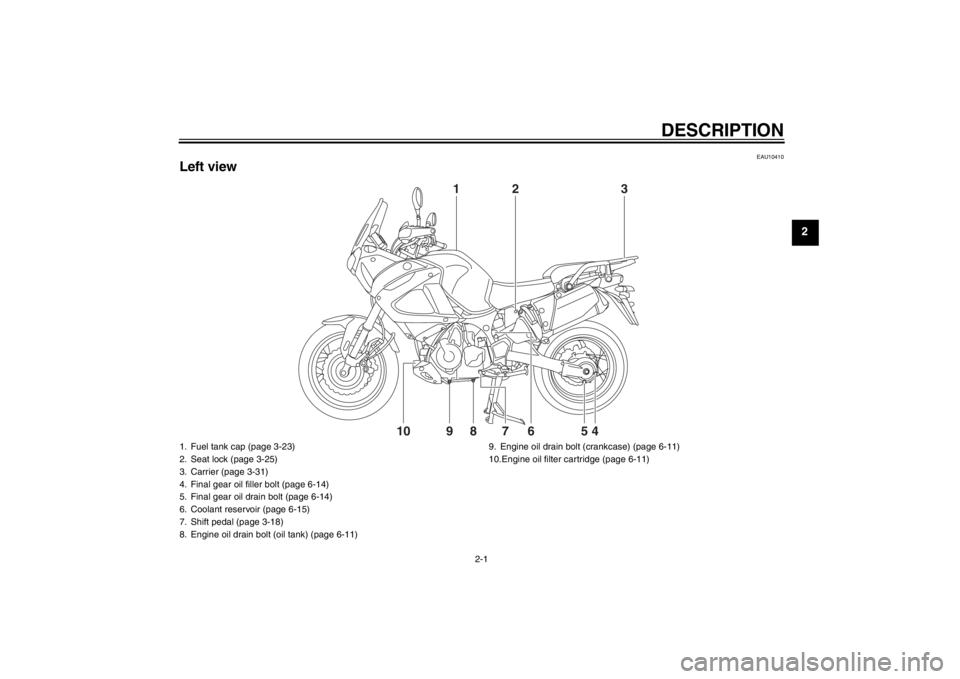
DESCRIPTION
2-1
2
EAU10410
Left view
132
76 54
10 9 8
1. Fuel tank cap (page 3-23)
2. Seat lock (page 3-25)
3. Carrier (page 3-31)
4. Final gear oil filler bolt (page 6-14)
5. Final gear oil drain bolt (page 6-14)
6. Coolant reservoir (page 6-15)
7. Shift pedal (page 3-18)
8. Engine oil drain bolt (oil tank) (page 6-11) 9. Engine oil drain bolt (crankcase) (page 6-11)
10.Engine oil filter cartridge (page 6-11)
U23PE3E0.book Page 1 Monday, July 30, 2012 8:44 AM
Page 14 of 108
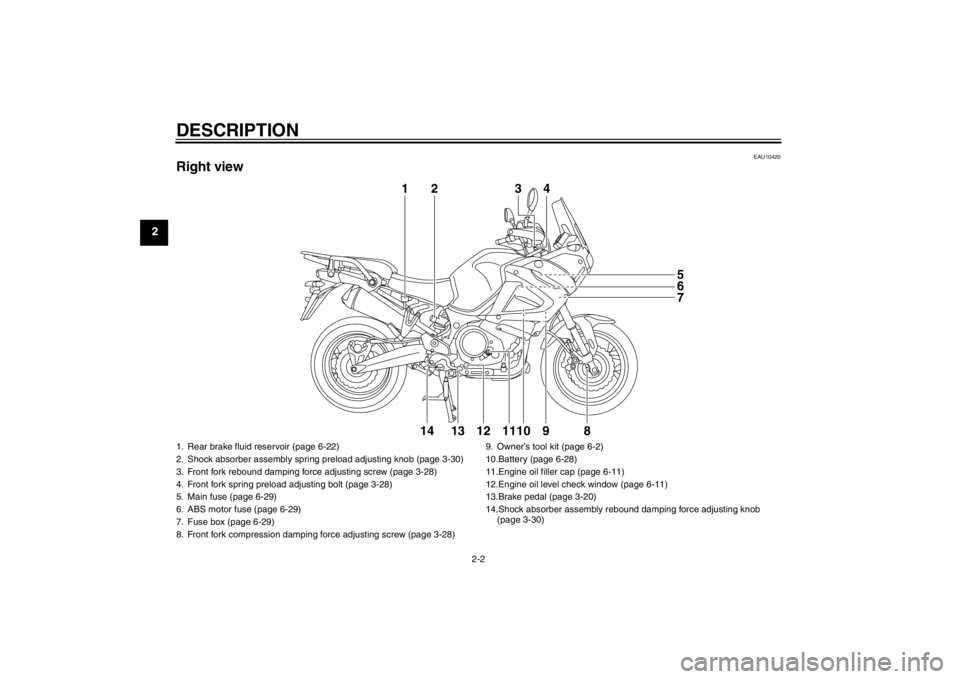
DESCRIPTION
2-2
2
EAU10420
Right view
2
1
43
85
6
7
9
14 11 13 12 10
1. Rear brake fluid reservoir (page 6-22)
2. Shock absorber assembly spri ng preload adjusting knob (page 3-30)
3. Front fork rebound damping force adjusting screw (page 3-28)
4. Front fork spring preload adjusting bolt (page 3-28)
5. Main fuse (page 6-29)
6. ABS motor fuse (page 6-29)
7. Fuse box (page 6-29)
8. Front fork compression damping force adjusting screw (page 3-28) 9. Owner’s tool kit (page 6-2)
10.Battery (page 6-28)
11.Engine oil filler cap (page 6-11)
12.Engine oil level check window (page 6-11)
13.Brake pedal (page 3-20)
14.Shock absorber assembly
rebound damping force adjusting knob
(page 3-30)U23PE3E0.book Page 2 Monday, July 30, 2012 8:44 AM
Page 19 of 108
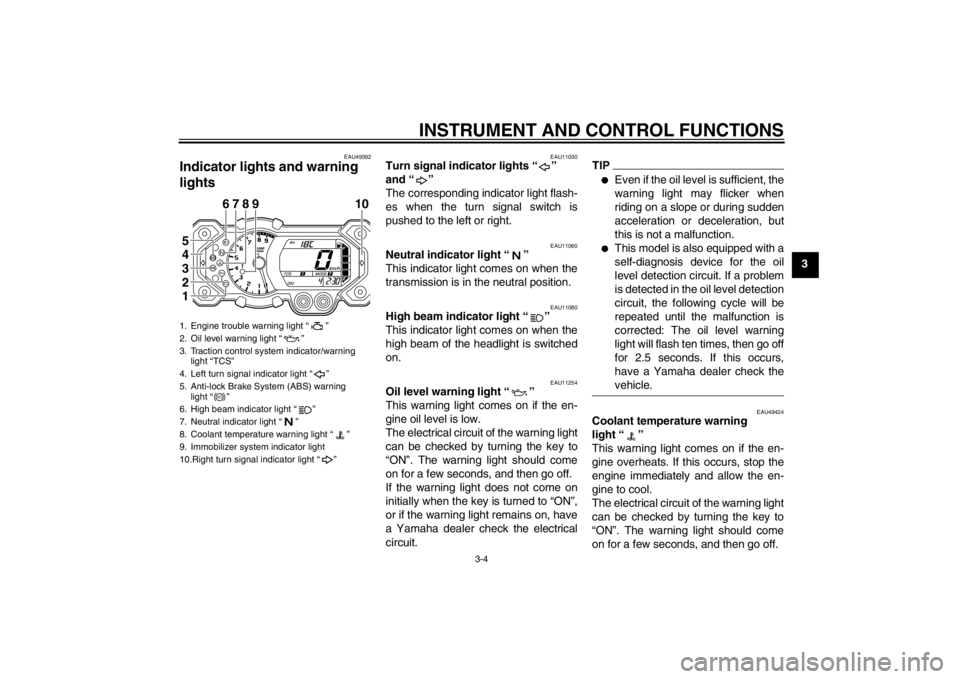
INSTRUMENT AND CONTROL FUNCTIONS
3-4
3
EAU49392
Indicator lights and warning
lights
EAU11030
Turn signal indicator lights “ ”
and “ ”
The corresponding indicator light flash-
es when the turn signal switch is
pushed to the left or right.
EAU11060
Neutral indicator light “ ”
This indicator light comes on when the
transmission is in the neutral position.
EAU11080
High beam indicator light “ ”
This indicator light comes on when the
high beam of the headlight is switched
on.
EAU11254
Oil level warning light “ ”
This warning light comes on if the en-
gine oil level is low.
The electrical circuit of the warning light
can be checked by turning the key to
“ON”. The warning light should come
on for a few seconds, and then go off.
If the warning light does not come on
initially when the key is turned to “ON”,
or if the warning light remains on, have
a Yamaha dealer check the electrical
circuit.
TIP●
Even if the oil level is sufficient, the
warning light may flicker when
riding on a slope or during sudden
acceleration or deceleration, but
this is not a malfunction.
●
This model is also equipped with a
self-diagnosis device for the oil
level detection circuit. If a problem
is detected in the oil level detection
circuit, the following cycle will be
repeated until the malfunction is
corrected: The oil level warning
light will flash ten times, then go off
for 2.5 seconds. If this occurs,
have a Yamaha dealer check the
vehicle.
EAU49424
Coolant temperature warning
light “ ”
This warning light comes on if the en-
gine overheats. If this occurs, stop the
engine immediately and allow the en-
gine to cool.
The electrical circuit of the warning light
can be checked by turning the key to
“ON”. The warning light should come
on for a few seconds, and then go off.
1. Engine trouble warning light “ ”
2. Oil level warning light “ ”
3. Traction control system indicator/warning light “TCS”
4. Left turn signal indicator light “ ”
5. Anti-lock Brake System (ABS) warning light “ ”
6. High beam indicator light “ ”
7. Neutral indicator light “ ”
8. Coolant temperature warning light “ ”
9. Immobilizer system indicator light
10.Right turn signal indicator light “ ”
6
10
789
12345
ABS
U23PE3E0.book Page 4 Monday, July 30, 2012 8:44 AM
Page 51 of 108
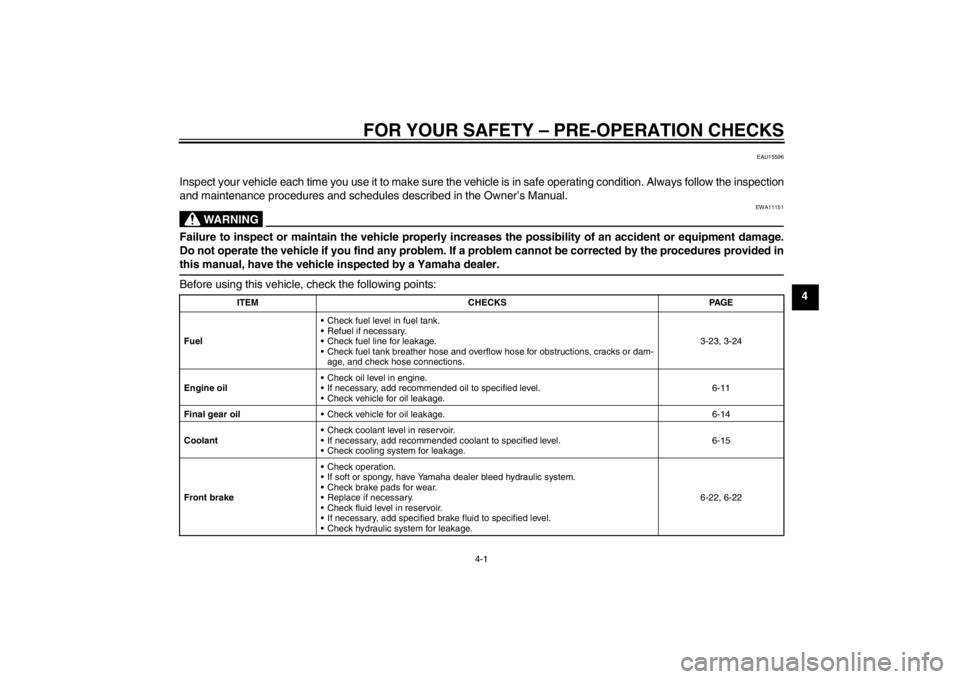
FOR YOUR SAFETY – PRE-OPERATION CHECKS
4-1
4
EAU15596
Inspect your vehicle each time you use it to make sure the vehicle is in safe operating condition. Always follow the inspection
and maintenance procedures and schedules described in the Owner’s Manual.
WARNING
EWA11151
Failure to inspect or maintain the vehicle properly increases the possibility of an accident or equipment damage.
Do not operate the vehicle if you find any problem. If a problem cannot be corrected by the procedures provided in
this manual, have the vehicle inspected by a Yamaha dealer.Before using this vehicle, check the following points:
ITEMCHECKS PAGE
Fuel Check fuel level in fuel tank.
Refuel if necessary.
Check fuel line for leakage.
Check fuel tank breather hose and overflow hose for obstructions, cracks or dam-
age, and check hose connections. 3-23, 3-24
Engine oil Check oil level in engine.
If necessary, add recommended oil to specified level.
Check vehicle for oil leakage. 6-11
Final gear oil Check vehicle for oil leakage. 6-14
Coolant Check coolant level in reservoir.
If necessary, add recommended coolant to specified level.
Check cooling system for leakage. 6-15
Front brake Check operation.
If soft or spongy, have Yamaha dealer bleed hydraulic system.
Check brake pads for wear.
Replace if necessary.
Check fluid level in reservoir.
If necessary, add specified brake fluid to specified level.
Check hydraulic system for leakage. 6-22, 6-22
U23PE3E0.book Page 1 Monday, July 30, 2012 8:44 AM
Page 53 of 108
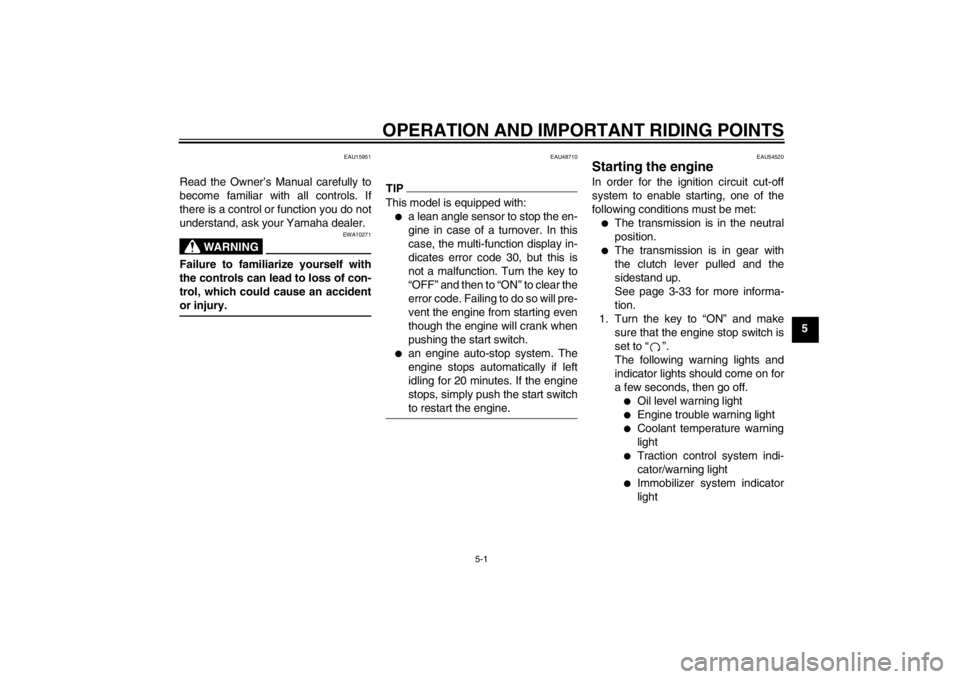
OPERATION AND IMPORTANT RIDING POINTS
5-1
5
EAU15951
Read the Owner’s Manual carefully to
become familiar with all controls. If
there is a control or function you do not
understand, ask your Yamaha dealer.
WARNING
EWA10271
Failure to familiarize yourself with
the controls can lead to loss of con-
trol, which could cause an accident
or injury.
EAU48710
TIPThis model is equipped with:●
a lean angle sensor to stop the en-
gine in case of a turnover. In this
case, the multi-function display in-
dicates error code 30, but this is
not a malfunction. Turn the key to
“OFF” and then to “ON” to clear the
error code. Failing to do so will pre-
vent the engine from starting even
though the engine will crank when
pushing the start switch.
●
an engine auto-stop system. The
engine stops automatically if left
idling for 20 minutes. If the engine
stops, simply push the start switch
to restart the engine.
EAU54520
Starting the engine In order for the ignition circuit cut-off
system to enable starting, one of the
following conditions must be met:●
The transmission is in the neutral
position.
●
The transmission is in gear with
the clutch lever pulled and the
sidestand up.
See page 3-33 for more informa-
tion.
1. Turn the key to “ON” and make sure that the engine stop switch is
set to “ ”.
The following warning lights and
indicator lights should come on for
a few seconds, then go off.●
Oil level warning light
●
Engine trouble warning light
●
Coolant temperature warning
light
●
Traction control system indi-
cator/warning light
●
Immobilizer system indicator
light
U23PE3E0.book Page 1 Monday, July 30, 2012 8:44 AM
Page 55 of 108
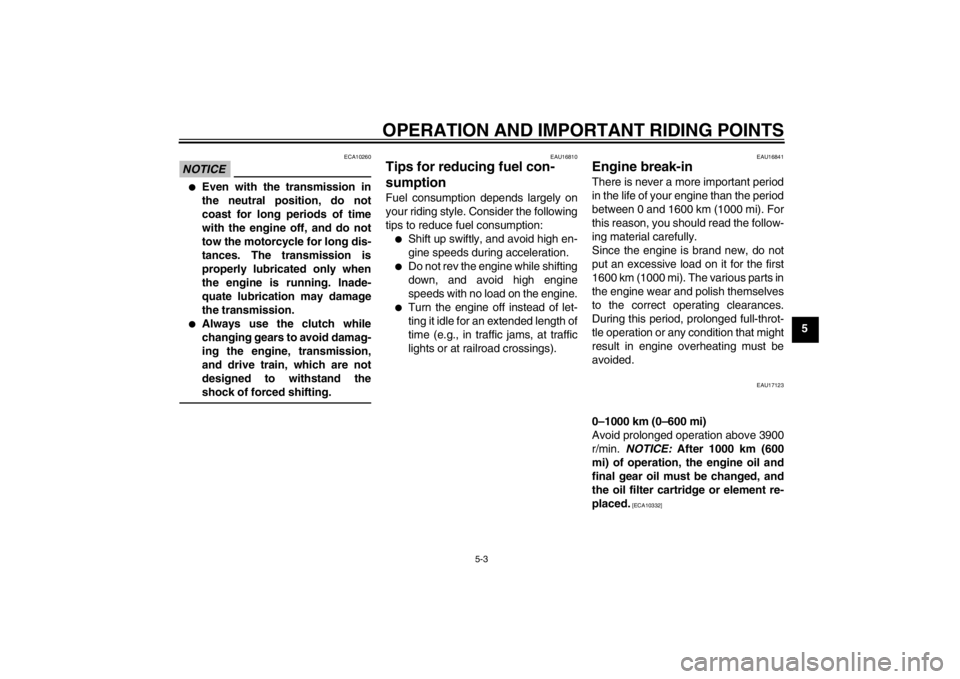
OPERATION AND IMPORTANT RIDING POINTS
5-3
5
NOTICE
ECA10260
●
Even with the transmission in
the neutral position, do not
coast for long periods of time
with the engine off, and do not
tow the motorcycle for long dis-
tances. The transmission is
properly lubricated only when
the engine is running. Inade-
quate lubrication may damage
the transmission.
●
Always use the clutch while
changing gears to avoid damag-
ing the engine, transmission,
and drive train, which are not
designed to withstand the
shock of forced shifting.
EAU16810
Tips for reducing fuel con-
sumption Fuel consumption depends largely on
your riding style. Consider the following
tips to reduce fuel consumption:●
Shift up swiftly, and avoid high en-
gine speeds during acceleration.
●
Do not rev the engine while shifting
down, and avoid high engine
speeds with no load on the engine.
●
Turn the engine off instead of let-
ting it idle for an extended length of
time (e.g., in traffic jams, at traffic
lights or at railroad crossings).
EAU16841
Engine break-in There is never a more important period
in the life of your engine than the period
between 0 and 1600 km (1000 mi). For
this reason, you should read the follow-
ing material carefully.
Since the engine is brand new, do not
put an excessive load on it for the first
1600 km (1000 mi). The various parts in
the engine wear and polish themselves
to the correct operating clearances.
During this period, prolonged full-throt-
tle operation or any condition that might
result in engine overheating must be
avoided.
EAU17123
0–1000 km (0–600 mi)
Avoid prolonged operation above 3900
r/min. NOTICE: After 1000 km (600
mi) of operation, the engine oil and
final gear oil must be changed, and
the oil filter cartridge or element re-
placed.
[ECA10332]
U23PE3E0.book Page 3 Monday, July 30, 2012 8:44 AM
Page 62 of 108

PERIODIC MAINTENANCE AND ADJUSTMENT
6-6
6
21*Rear suspension re-
lay arm and con-
necting arm
pivoting points Check operation.
√√√√
22 Engine oil Change.
Check oil level and vehicle for oil
leakage. √√√√√√
23 Engine oil filter car-
tridge Replace.
√√√
24 *Cooling system Check coolant level and vehicle
for coolant leakage. √√√√√
Change coolant. Every 3 years
25 Final gear oil Check oil level and vehicle for oil
leakage. √√ √
Change. √√√
26 *Front and rear brake
switches
Check operation.
√√√√√√
27 Moving parts and
cables
Lubricate.
√√√√√
28 *Throttle grip Check operation.
Check throttle grip free play, and
adjust if necessary.
Lubricate cable and grip housing. √√√√√
29 *Lights, signals and
switches Check operation.
Adjust headlight beam.
√√√√√√
NO. ITEM CHECK OR MAINTENANCE JOB
ODOMETER READING
ANNUAL
CHECK
1000 km
(600 mi) 10000 km
(6000 mi) 20000 km
(12000 mi) 30000 km
(18000 mi) 40000 km
(24000 mi)U23PE3E0.book Page 6 Monday, July 30, 2012 8:44 AM
Page 66 of 108
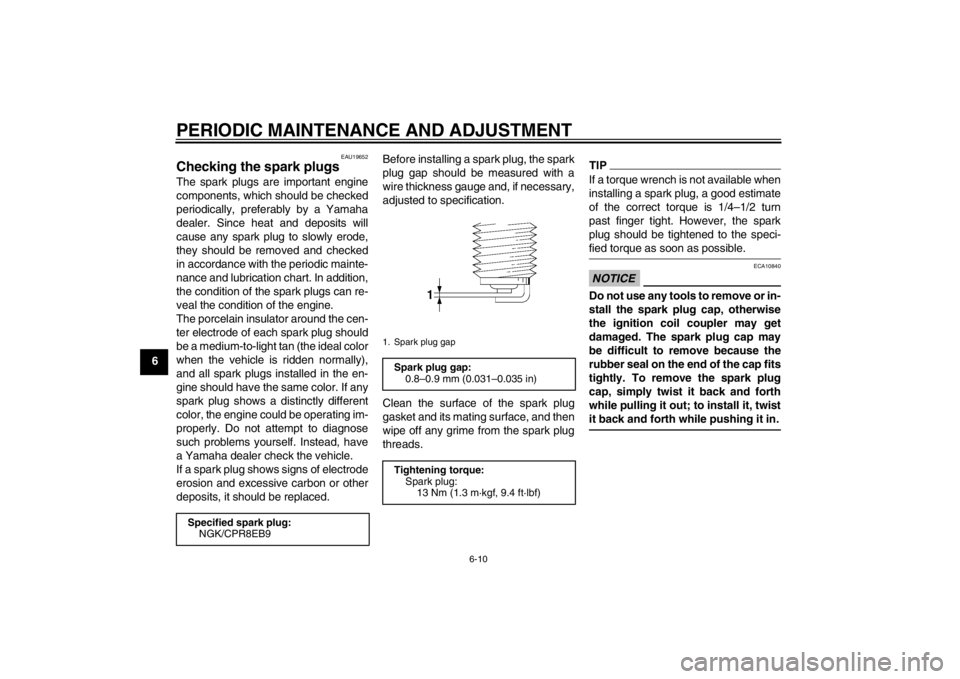
PERIODIC MAINTENANCE AND ADJUSTMENT
6-10
6
EAU19652
Checking the spark plugs The spark plugs are important engine
components, which should be checked
periodically, preferably by a Yamaha
dealer. Since heat and deposits will
cause any spark plug to slowly erode,
they should be removed and checked
in accordance with the periodic mainte-
nance and lubrication chart. In addition,
the condition of the spark plugs can re-
veal the condition of the engine.
The porcelain insulator around the cen-
ter electrode of each spark plug should
be a medium-to-light tan (the ideal color
when the vehicle is ridden normally),
and all spark plugs installed in the en-
gine should have the same color. If any
spark plug shows a distinctly different
color, the engine could be operating im-
properly. Do not attempt to diagnose
such problems yourself. Instead, have
a Yamaha dealer check the vehicle.
If a spark plug shows signs of electrode
erosion and excessive carbon or other
deposits, it should be replaced.Before installing a spark plug, the spark
plug gap should be measured with a
wire thickness gauge and, if necessary,
adjusted to specification.
Clean the surface of the spark plug
gasket and its mating surface, and then
wipe off any grime from the spark plug
threads.
TIPIf a torque wrench is not available when
installing a spark plug, a good estimate
of the correct torque is 1/4–1/2 turn
past finger tight. However, the spark
plug should be tightened to the speci-
fied torque as soon as possible.NOTICE
ECA10840
Do not use any tools to remove or in-
stall the spark plug cap, otherwise
the ignition coil coupler may get
damaged. The spark plug cap may
be difficult to remove because the
rubber seal on the end of the cap fits
tightly. To remove the spark plug
cap, simply twist it back and forth
while pulling it out; to install it, twist
it back and forth while pushing it in.
Specified spark plug:
NGK/CPR8EB9
1. Spark plug gapSpark plug gap:0.8–0.9 mm (0.031–0.035 in)
Tightening torque: Spark plug:13 Nm (1.3 m·kgf, 9.4 ft·lbf)
U23PE3E0.book Page 10 Monday, July 30, 2012 8:44 AM
Page 67 of 108
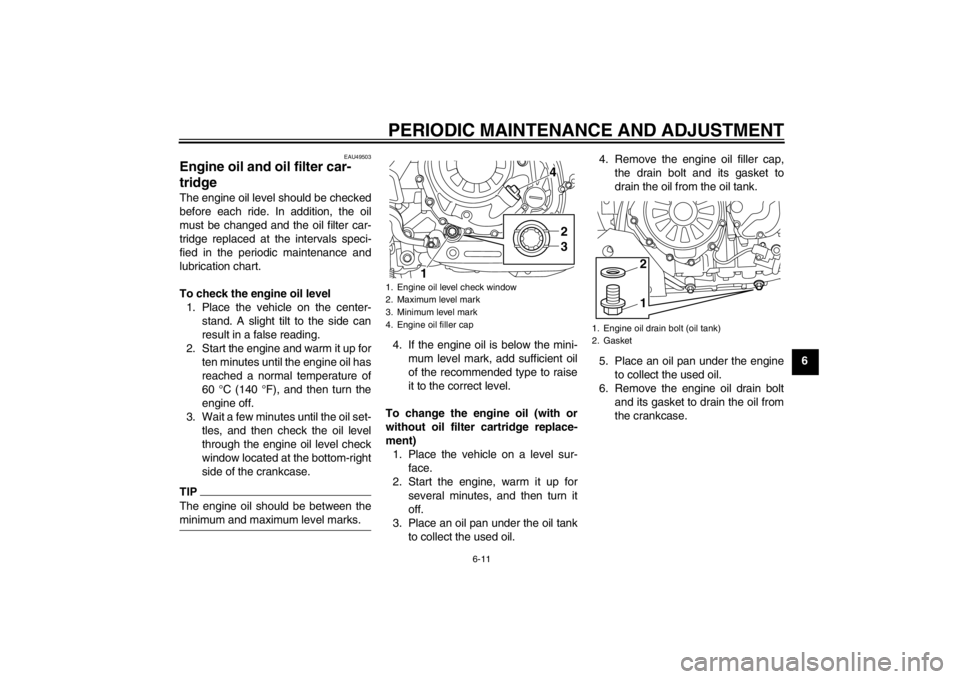
PERIODIC MAINTENANCE AND ADJUSTMENT
6-11
6
EAU49503
Engine oil and oil filter car-
tridge The engine oil level should be checked
before each ride. In addition, the oil
must be changed and the oil filter car-
tridge replaced at the intervals speci-
fied in the periodic maintenance and
lubrication chart.
To check the engine oil level1. Place the vehicle on the center- stand. A slight tilt to the side can
result in a false reading.
2. Start the engine and warm it up for ten minutes until the engine oil has
reached a normal temperature of
60 °C (140 °F), and then turn the
engine off.
3. Wait a few minutes until the oil set- tles, and then check the oil level
through the engine oil level check
window located at the bottom-right
side of the crankcase.TIPThe engine oil should be between the
minimum and maximum level marks.
4. If the engine oil is below the mini-mum level mark, add sufficient oil
of the recommended type to raise
it to the correct level.
To change the engine oil (with or
without oil filter cartridge replace-
ment) 1. Place the vehicle on a level sur- face.
2. Start the engine, warm it up for several minutes, and then turn it
off.
3. Place an oil pan under the oil tank to collect the used oil. 4. Remove the engine oil filler cap,
the drain bolt and its gasket to
drain the oil from the oil tank.
5. Place an oil pan under the engine to collect the used oil.
6. Remove the engine oil drain bolt and its gasket to drain the oil from
the crankcase.1. Engine oil level check window
2. Maximum level mark
3. Minimum level mark
4. Engine oil filler cap
42
3
1
1. Engine oil drain bolt (oil tank)
2. Gasket
12
U23PE3E0.book Page 11 Monday, July 30, 2012 8:44 AM